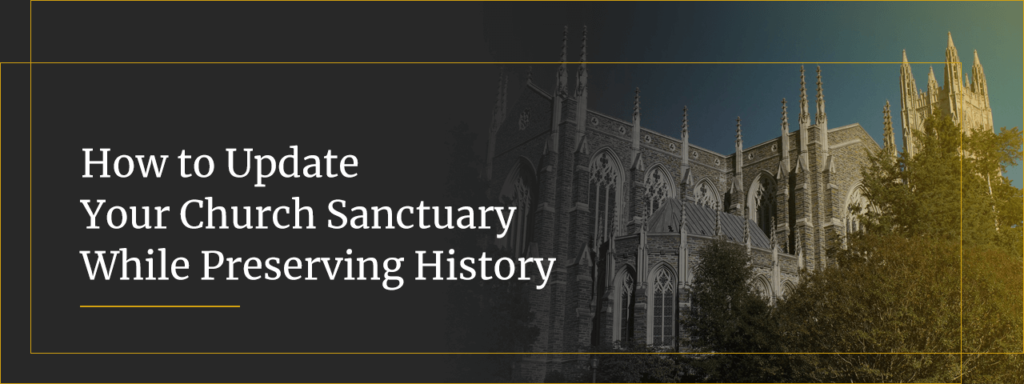
If you’re wondering whether it’s time to update your church sanctuary, the answer is likely yes. As one blogger for Christianity Today points out, churches renovate their building every 30 years on average — a remarkably long time when you consider how quickly styles change and how much wear a church can experience.
Jump to Sections:
- Why Update Church Facilities?→
- Church Improvement Ideas→
- How to Remodel an Old Church→
- Things to Consider When Planning Church Sanctuary Makeovers→
- Church Pew Refinishing Services from The Keck Group→
A church sanctuary should build a sense of community and encourage worship. So why are churches reluctant to renovate their facilities? Aside from practical concerns like finances, another hang-up for many is the fear of losing a church’s history. Especially for churches built a century ago or more, preserving history should be a concern.
Fortunately, you don’t need to reject historical features of your church in order to update the space. You can highlight historical features in your sanctuary and change out other features to enhance your sanctuary’s functionality and appearance.
Why Update Church Facilities?
There are many reasons to consider updating old churches, especially when it comes to the centerpiece of the building: the sanctuary. Everything from a full-scale renovation to a minor refresh can improve and modernize your church. Updating your church sanctuary can improve the atmosphere for your congregation and help you make a positive impression with guests. In addition, updating a church sanctuary can deliver the following benefits.
1. Add Valuable Function
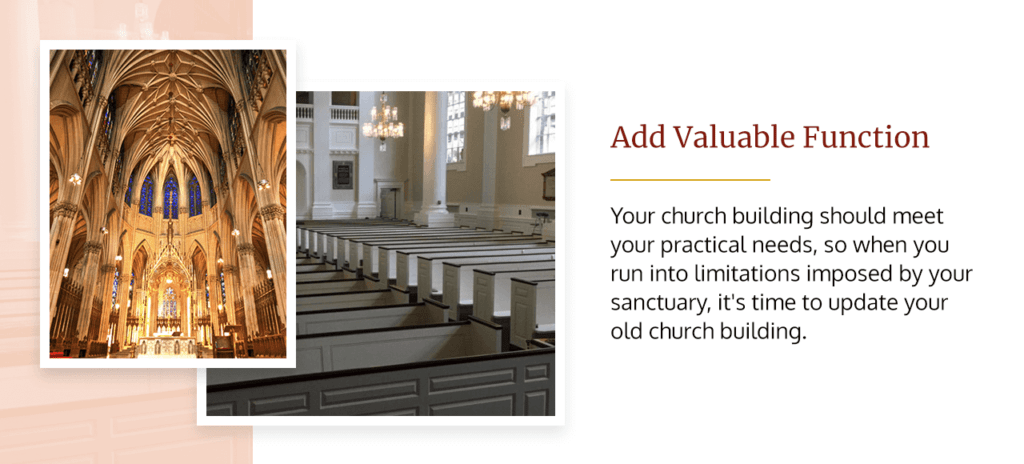
Some updates are intended to make a sanctuary more functional. For example, this could include installing equipment for a modern AV setup or restructuring the pulpit platform. It could even involve expanding the sanctuary to accommodate a growing congregation. Your church building should meet your practical needs, so when you run into limitations imposed by your sanctuary, it’s time to update your old church building.
2. Restore Worn Features
A sanctuary should have an uplifting atmosphere. If the historic features of your church have lost their original beauty, it’s time to restore and refresh these features so they can shine as they once did. This might include restoring your church pews, pulpit and other central features. Elements like carpet and paint may look faded or stained, signaling it’s time for a refresh to make an old sanctuary feel new.
3. Enhance Modern Appeal
Another reason to consider planning some traditional church updates is to engage with contemporary design preferences — preferences younger members of your congregation and guests are likely to have. The good news is that you don’t have to throw out the old features in order to modernize a traditional church. You can still preserve original features that serve as beautiful reminders of the church’s founding while adding modern touches that freshen up the space.
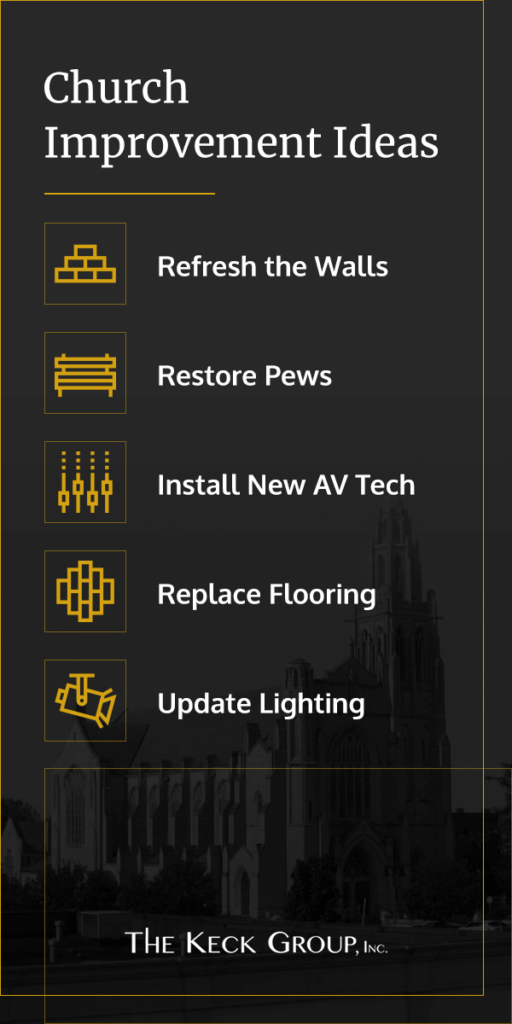
Church Improvement Ideas
There are plenty of ways to improve your sanctuary without having to take on a major renovation. Look around and consider which aspects of your sanctuary could use a makeover. If there are valuable historical features that have become worn over time, you may be able to restore these features to their original splendor.
Other things in your sanctuary may simply appear dated. Perhaps it’s orange carpet or funky light fixtures installed decades ago that have lost their charm and now detract from your sanctuary’s beauty. You are better off to replace these features with updated versions.
We have five ideas for how to modernize a traditional church sanctuary without covering up your church’s history.
1. Refresh the Walls
Most people know from experience what a difference a fresh coat of paint can make in a space. Even if you choose to keep the same wall color you had before, a new coat of paint is a great and fairly inexpensive way to spruce up your sanctuary. If you want to make a noticeable difference, choose a new color for your sanctuary walls. Most churches opt for light neutral colors like white and cream since they reflect light and brighten up the room.
If a bolder color would better suit your church’s personality, don’t be afraid to try something different. You may want to paint most walls a neutral color and designate one wall — such as the wall behind the platform — as an accent wall. You could paint this wall in a darker color or cover it in another material, such as exposed brick, if that would fit the style of your building.
2. Restore Pews
Many church sanctuaries are outfitted with wooden pews that have been there for many years, possibly since the church’s founding. Some may suggest replacing these pews with chairs as a way to update your sanctuary, and you may be tempted to do so if your pews look tired or dated. However, if you want to preserve your church’s history, keeping your pew seating is an excellent way to do so.
Specialists who understand how to preserve old church furniture, like The Keck Group, can restore and refinish your pews. Restoration can erase years of wear and layers of finish that obscure the wood grain to return your pews to their former beauty. You can also change the color or the cushion upholstery to give your pews a whole new look. Pew seating may be more traditional than chairs, but you can modernize your pews while continuing to honor the tradition of community seating.
3. Install New AV Tech
If you’re struggling with outmoded audiovisual equipment, this is an area you may want to focus on in your renovation. Not all churches need a high-tech worship experience. Simple, reliable technology can serve its purpose without detracting from the worship experience. Perhaps it’s time to install a new sound system or a new projector. Or maybe you need new boom microphones in the choir loft or stage lights above the platform. Assess your church’s needs and consider what new equipment might help.
Remember that when it comes to sound quality, acoustics are also very important. You can make the most of your sound system by improving the sanctuary’s acoustics. This might include installing acoustic panels to the wall or ceiling or choosing carpet for the floor.
4. Replace Flooring
Even if you don’t allow food and drink into your sanctuary, floors can still experience a lot of wear from foot traffic. If you look down in your sanctuary and see worn, faded carpet, it may be time for a change. Carpet is a popular choice for sanctuaries because it dampens sound, allowing people to walk in and out without creating a disturbance. Selecting darker-colored carpets can help conceal wear. It’s also smart to choose a solid color or a subtle pattern that won’t appear dated in a few years.
If you want to try a hard floor with a carpet runner for walking, you can consider polished concrete, tile or hardwood. Old churches may find beautiful hardwood hiding beneath existing carpet or other flooring that has been installed over the years. Refinishing these floors can help you update the appearance and bring out the church’s historical beauty.
5. Update Lighting
Lighting is an important aspect of any church sanctuary. Historically, churches sought to invite light in to symbolize the light of God’s presence. In addition to natural light, you can enhance the lighting and decor of your sanctuary with the right light fixtures. For church designs that don’t include windows in the sanctuary, light fixtures may be your sole source of lighting. When choosing lighting, you’ll want to consider the look of the fixtures as well as the light they provide.
Choose fixtures that fit the overall design style of your sanctuary. There is a wide range of options to consider, from the minimalist look of recessed lighting to opulent chandeliers. You may also want to switch to more energy-efficient lightbulbs, or bulbs that cast a warmer or brighter glow, depending on what your sanctuary needs. Installing dimmers is a great way to allow more control over the lighting so you can set the right mood. For a Good Friday service, for example, you could choose to keep the lights low for somber reflection.
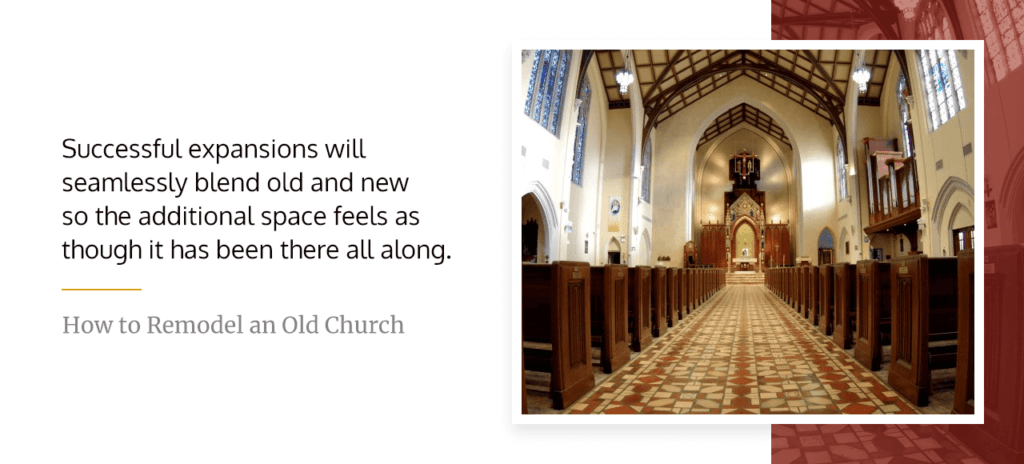
How to Remodel an Old Church
In many cases, taking the steps above to modernize your sanctuary will be a sufficient update. However, some churches may want to plan a larger-scale renovation with construction projects in addition to cosmetic and restorative fixes.
This may be the case if you want to expand the size of your sanctuary. Most churches count it a blessing to welcome new members and grow, but this can pose a problem when you begin to exceed your sanctuary’s seating capacity. A general guideline is that once you reach 80% of your capacity, you should consider expanding to add more seating. Some churches may choose to build a new sanctuary on their property or move into a new building so they can preserve their existing sanctuary as a chapel. If your sanctuary represents your church’s rich history, you might prefer to continue using it for regular worship.
For expansions or other major remodel projects, you should work with a professional to create construction plans that meet your needs and preserve aspects of your sanctuary’s history. Successful expansions will seamlessly blend old and new so the additional space feels as though it has been there all along.
When planning an expansion, don’t forget to plan for seating. To preserve your sanctuary’s historical beauty, you can employ carpenters who specialize in church furniture to replicate your existing pews. You don’t need to replace your pews in order to have matching seating. If you have extra unused space in your sanctuary, you may be able to add seating without the need to tear down walls.
In addition to expansion remodels, there are other ways you can modernize your church sanctuary through remodeling. For example, you may want to reconstruct your platform to be more accommodating for a contemporary praise band. Or you may want to add features like a built-in baptismal or choir lofts. Other examples of remodeling ideas are adding skylights to fill the sanctuary with natural light or adding more points of entry to the sanctuary for comfortable traffic flow.
Things to Consider When Planning Church Sanctuary Makeovers
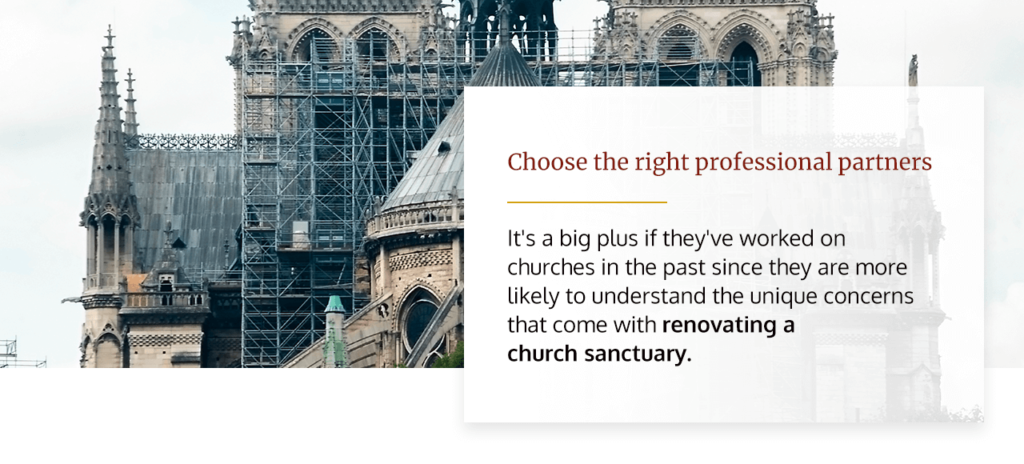
When you’re considering how to modernize your church, there is more to think about than the changes you want to see. Factor in these four tips when you’re planning:
- Get buy-in from the congregation: First, make sure your church is on board with the decision to renovate. As Pastor Chris Hefner points out, the decision to renovate shouldn’t just be the pastor’s or any one person’s idea. It should be a group effort, possibly steered by a committee, to ensure no one person is calling the shots. Churches are communal spaces, and you want everyone to enjoy the changes. Be prepared for some people to complain or disapprove of changes. It is usually impossible to appeal to everyone’s preferences.
- Work with a budget: Make sure you create a realistic budget for your project, and allow that budget to guide you as you make decisions. You may even want to create a giving campaign to cover the renovations. Be prepared to adjust your budget as needed. The process of remodeling may reveal other needs, or you may find you’re better off to invest more than you originally planned in order to achieve quality results.
- Choose the right professional partners: There are many contractors available, and it’s okay to be picky when choosing who your church will partner with to complete your renovations. As you find companies or individuals you may want to work with, ask to see examples of their work. It’s a big plus if they’ve worked on churches in the past since they are more likely to understand the unique concerns that come with renovating a church sanctuary.
- Plan to minimize the disruption: Don’t forget logistical concerns that arise when you’re working on a sanctuary — namely, you may not be able to meet there for services until the project is complete. If necessary, look for another place to meet temporarily. If you’re doing minor work, you may be able to complete it during the week and still meet in the sanctuary for church on Sunday. If you’re having pews restored by our craftsmen, we’ll install temporary seating in the meantime so you won’t miss a beat.

Breathe New Life Into Your Sanctuary With Help From The Keck Group
For over 40 years, The Keck Group has been refinishing pews and other church furniture. We’re experienced in removing signs of wear and bringing beautiful wooden pews back to life. We can also outfit your pews with new cushions and other accessories for a fresh look and added function.
We understand how a traditional church remodel can preserve and celebrate your church’s history. We strive to make the pew restoration process easy, so you can focus on other aspects of your church’s remodel or refresh. At The Keck Group, we deliver high-quality craftsmanship with a short turnaround and a fair price. Look through our past projects and contact us today to learn more.
Page updated on October 13, 2021
